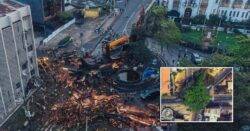The Cotton Tree has long symbolised liberty and freedom (Picture: Getty Images)
A tree that has towered over Sierra Leone for centuries and symbolised freedom to formerly enslaved people has been felled by a storm.
The 70-metre (230ft) Ceiba pentandra – known to Sierra Leoneans as Cotton Tree – lost all its branches and leaves during a night of rainfall in Freetown yesterday.
The tree, rooted in a busy roundabout in the capital city by the Supreme Court and State House, was thought to be around 400 years old.
President Julius Maada Bio tweeted: ‘The iconic Cotton Tree has fallen due to the heavy downpour of rain in our capital this evening.
‘A great loss to the nation. It was regarded as a symbol of liberty and freedom by early settlers.
‘We will have something at the same spot that bears testament to the great Cotton Tree’s place in our history.
The colossal centuries-old Cotton Tree was ripped apart by rainfall and wind (Picture: Courtesy Zebek/SWNS)
The tree grew in the middle of Tower Hill, a well-kept government and residential neighbourhood in northern Freetown (Picture: Courtesy Zebek/SWNS)
Only the battered base of the trunk remains (Picture: Courtesy Zebek/SWNS)
‘All voices will be brought together for this.’
The Cotton Tree along the West African country’s shoreline was among the first sights seen by freed American slaves when they docked in the late 1700s.
Gathering under its branches, the group, who were freed for fighting for the British during the American War of Independence, prayed and sang.
It went on to become a major landmark for Sierra Leone, featured on its banknotes and celebrated in children’s nursery rhymes.
Freetown residents have ever since prayed under the tree, but this morning they gathered by what is now just its giant trunk in mourning.
It was something the country had long braced itself for. A few branches were broken off during a heavy rainstorm last week.
Snapped branches and leaves covered the roundabout as diggers cleared out the area (Picture: Courtesy Zebek/SWNS)
It’s thought to have been around 400 years old (Picture: Courtesy Zebek/SWNS)
More than a hundred people gathered to mourn the tree (Picture: Courtesy Zebek/SWNS)
Among the last to see the tree standing last night was Victor Tutu Rogers, who told Reuters he passed by it at around 9:40pm.
‘I dashed round the cotton tree on my way from work, because I feared the branches might fall,’ he said.
‘Shortly after that there was a heavy lightning and I heard a heavy bang – the sound of the tree falling behind me.’
No one was injured, the government added, though the ripped-apart branches and bark damaged some nearby buildings and cars.
Historians have long been stumped as to how old the Cotton Tree is but records date back to at least 1787.
Sierra Leone has been in the throes of its months-long rainy season since early May and will be until November.
The president said it is a ‘great loss’ for Sierra Leone (Picture: Courtesy Zebek/SWNS)
Only a few metres of the trunk was left (Picture: Courtesy Zebek/SWNS)
For the early settlers in Sierra Leone, recently freed from slavery, the tree captured the freedom they had long sought (Picture: Courtesy Zebek/SWNS)
The country is among the most vulnerable in the world to the upending consequences of climate change, with a mudslide in Freetown killing more than 1,100 people in 2017.
Often reaching the skies at a height of 70 metres, or about 230 feet, the Ceiba pentandra is otherwise known as a kapok tree.
The umbrella-shaped trees are known for their chunky roots crawling out from their trunk and the vines and air plants that grow between their branches in the tropics.
According to ancient Maya, the kapok tree was the symbol of the universe. Its roots dug into the underworld and its branches reached the upper world.
It’s also the national emblem of Guatemala, Puerto Rico and Equatorial Guinea.
Get in touch with our news team by emailing us at webnews@metro.co.uk.
For more stories like this, check our news page.
‘It was regarded as a symbol of liberty and freedom by early settlers.’





